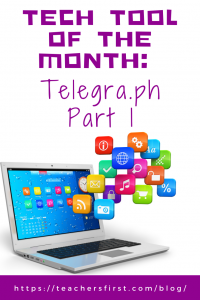Telegra.ph is a straightforward writing tool for publishing web content, such as a digital story or a blog. No registration is needed; click to fill in the post’s title, your name, and then add content. You can upload photos, videos, and Tweets. When you finish, click to publish. After publishing, you can continue editing or adding content. Click the publish button again to post the new changes. Finally, copy the URL to share on the web.
Applying the Triple E Framework
The Triple E Framework, created by Dr. Liz Kolb, is built on the belief that “effective technology integration begins with good instructional strategies and not fancy tools” (tripleeframework.com). Dr. Kolb wrote a book on Learning First, Technology Second (ISTE, 2017) that lays out the three main uses for technology in education: to Engage, Enhance, or Extend learning goals. We can use this framework to decipher why we are using specific tools in the classroom. Here is a rubric based on the Triple E Framework you can use to evaluate whether Telegra.ph (or any other technology) is a good fit with your learning goals and whether you should use it in your lesson.
- Engage in learning goals: The students are more focused on the task because they are engaged in creating digital web content and can work at their own pace at Telegra.ph. There are no badges, games, advertisements, or other extras to distract from the process of learning. The students are active social learners as they type and publish their work. The students are motivated to begin the learning process since they can make decisions, add images, videos, and publish their work.
- Enhance learning goals: Telegra.ph allows students to use technology to make connections to understand concepts and ideas. Students creating their own web content can enhance learning objectives as it enables students to share questions, concepts, and information. The images, videos, and written information allow students to demonstrate a more sophisticated understanding of the topic by creating their original work. Students use higher-order thinking skills to organize their thoughts and words for the digital stories/web content. Creativity is also included as students can add images, text, videos, and audio clips.
- Extend learning goals: Dr. Kolb describes extended learning as an opportunity for students to learn, connect, and collaborate outside of the regular school day and as a bridge between the school day and real-life experiences. Creating web content outside of the classroom using Telegra.ph would fit in with flipped, remote, or blended learning. Independent work and creativity can help students build skills used in everyday lives outside of the classroom environment. We are preparing our students for a world that doesn’t exist yet, but most jobs require independent motivation and knowledge of technology. Telegra.ph’s writing options will also help prepare students for learning (and writing) beyond the classroom.
SAMR Connection
The SAMR Model, by Dr. Ruben Puentedura, suggests that technology implementation has four levels. We can use this model as a guideline to analyze how we’re using technology tools in the classroom. For example, web content created using Telegra.ph can be at the level of Substitution, Augmentation, Modification, and Redefinition depending on the assignment and features used. Let’s talk about how we could take an activity (for example, creating web content as a digital story discussing characters in a novel the class is reading, possibly writing about the character with the least amount of power or the individual that changes the most throughout the story). Let’s discuss how we could use Telegra.ph and evolve this activity through the four levels of SAMR.
- Substitution: The substitution level is the most basic level of SAMR and refers to when technology acts as a direct substitute without any functional improvements. Two quick examples of this could be if students were viewing a teacher-created published piece of web content or if students created their own basic writing piece (about Colonial times) typing words rather than writing and stapling written pages together.
- Augmentation: At the level of augmentation, the technology acts as a direct substitute and includes some functional improvements. We could take our Telegra.ph Colonial Times activity to the level of augmentation by adding text, images, videos, Tweets. Text can be added between photos to explain the storyline. These options would not be possible without technology that offers functional improvements.
- Modification: The level of modification allows us to make (or modify) the activity into something more integrated with technology, meaning there is significant task redesign. Using the same Colonial Times writing activity, we could use Telegra.ph and move to the level of modification by having students create their own videos on YouTube to add to their web content.
- Redefinition: At the highest level, the technology allows for the creation of new previously inconceivable tasks. Returning to the example of the Telegra.ph Colonial Times writing activity, we could get to the level of redefinition by having students share their web stories/blogs (by URL) with parents using a class wiki page or by having the class create and share a Google Site with all of the Telegra.ph links.
Don’t miss Part 2 of the Tech Tool of the Month: Telegra.ph, where we’ll discuss using the tool and classroom use ideas. In the comments below, let us know how you have used Telegra.ph in your education setting.


